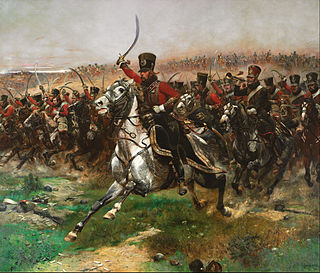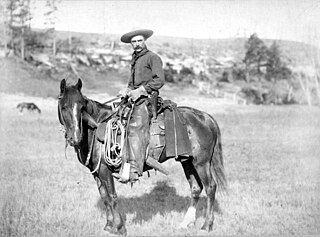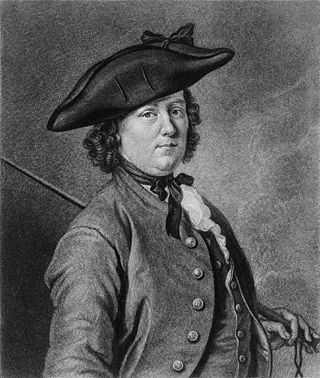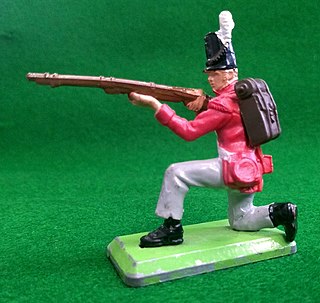
Timpo Toys Ltd. was a British toy company created in 1938 by Salomon [1] "Sally" Gawrylovitz (born in Frankfurt 1907, died September 28, 2000, in Zug, Switzerland), also known as Ally Gee. [2] [3]

Timpo Toys Ltd. was a British toy company created in 1938 by Salomon [1] "Sally" Gawrylovitz (born in Frankfurt 1907, died September 28, 2000, in Zug, Switzerland), also known as Ally Gee. [2] [3]
| | This section needs expansion. You can help by adding to it. (January 2018) |
A Jewish refugee from Germany, Gawrylovitz started as Toy Importers Company known as TIMPO in 1938. The company manufactured various toys out of wood, bakelite and composition until the end of World War II. [4]
Following the war, Timpo made hollowcast metal toy soldiers; with soldiers manufactured in plastic from 1954.
The firm ceased operations in 1978.




The assortment of Timpo Toys consisted of several figurine series, with the American frontier series and the Knight series forming the core of the product range. Since Timpo further developed the series in the course of production, some series could be divided into generations (e.g. there are four generations within the Cowboy series).
Overview of the series:
The following pictures show examples of Timpo plastic figures.

The American Civil War was a civil war in the United States between the Union and the Confederacy, which was formed in 1861 by states that had seceded from the Union. The central conflict leading to war was a dispute over whether slavery should be permitted to expand into the western territories, leading to more slave states, or be prohibited from doing so, which many believed would place slavery on a course of ultimate extinction.

Historically, cavalry are groups of soldiers or warriors who fight mounted on horseback. Until the 20th century, cavalry were the most mobile of the combat arms, operating as light cavalry in the roles of reconnaissance, screening, and skirmishing, or as heavy cavalry for decisive economy of force and shock attacks. An individual soldier in the cavalry is known by a number of designations depending on era and tactics, such as a cavalryman, horseman, trooper, cataphract, knight, drabant, hussar, uhlan, mamluk, cuirassier, lancer, dragoon, samurai or horse archer. The designation of cavalry was not usually given to any military forces that used other animals or platforms for mounts, such as chariots, camels or elephants. Infantry who moved on horseback, but dismounted to fight on foot, were known in the early 17th to the early 18th century as dragoons, a class of mounted infantry which in most armies later evolved into standard cavalry while retaining their historic designation.
1861 (MDCCCLXI) was a common year starting on Tuesday of the Gregorian calendar and a common year starting on Sunday of the Julian calendar, the 1861st year of the Common Era (CE) and Anno Domini (AD) designations, the 861st year of the 2nd millennium, the 61st year of the 19th century, and the 2nd year of the 1860s decade. As of the start of 1861, the Gregorian calendar was 12 days ahead of the Julian calendar, which remained in localized use until 1923.

The Army of Northern Virginia was the primary military force of the Confederate States of America in the Eastern Theater of the American Civil War. It was also the primary command structure of the Department of Northern Virginia. It was most often arrayed against the Union Army of the Potomac.

The American frontier, also known as the Old West, and popularly known as the Wild West, encompasses the geography, history, folklore, and culture associated with the forward wave of American expansion in mainland North America that began with European colonial settlements in the early 17th century and ended with the admission of the last few contiguous western territories as states in 1912. This era of massive migration and settlement was particularly encouraged by President Thomas Jefferson following the Louisiana Purchase, giving rise to the expansionist attitude known as "manifest destiny" and historians' "Frontier Thesis". The legends, historical events and folklore of the American frontier, known as the frontier myth, have embedded themselves into United States culture so much so that the Old West, and the Western genre of media specifically, has become one of the defining features of American national identity.

Playmobil is a German line of toys produced by the Brandstätter Group, headquartered in Zirndorf, Germany. The signature Playmobil toy is a 7.5 cm (3.0 in) tall human figure with a smiling face. A wide range of accessories, buildings and vehicles, as well as many sorts of animals, are also part of the Playmobil line.

A toy soldier is a miniature figurine that represents a soldier. The term applies to depictions of uniformed military personnel from all eras, and includes knights, cowboys, American Indians, pirates, samurai, and other subjects that involve combat-related themes. Toy soldiers vary from simple playthings to highly realistic and detailed models. The latter are of more recent development and are sometimes called model figures to distinguish them from traditional toy soldiers. Larger scale toys such as dolls and action figures may come in military uniforms, but they are not generally considered toy soldiers.

Many people have engaged in cross-dressing during wartime under various circumstances and for various motives. This has been especially true of women, whether while serving as a soldier in otherwise all-male armies, while protecting themselves or disguising their identity in dangerous circumstances, or for other purposes.

Army men, or plastic soldiers, are toy soldiers that are about 5 cm (2.0 in) tall and most commonly molded from low-density polyethylene plastic, which makes them durable and flexible. Unlike the more expensive toy soldiers available in hobby shops, army men are sold at low prices in discount stores and supermarkets. Army men are traditionally solid green or tan and almost always dressed in modern military uniforms and armed with 20th-century weapons. 'Jumbo' army men are a less common secondary scale with 4.75-inch (12.1 cm) soldiers made by the same process.
Elastolin was a trademark used by the German company O&M Hausser for the toy soldiers and other types of figures it manufactured from composite material and later from plastic. The Hausser firm was founded in 1904 by Christian Hausser and his sons Otto and Max. The factory was situated in Ludwigsburg near Stuttgart. Production of all figures was interrupted when the German economy was put on a "total war" footing in 1943. Limited production of composition figures resumed several years after the end of World War II in 1945. Hausser continued to use the brand name Elastolin when it began production of figures in a hard polystyrene plastic in 1955 while production of figures in the older sawdust-based composition material continued into the 1969. Hausser production of plastic figures continued through 1982. The company filed for bankruptcy in June 1983 and ceased production by the end of the year.

The state of Iowa played a significant role during the American Civil War in providing food, supplies, troops and officers for the Union army.

The first evidence of horses in warfare dates from Eurasia between 4000 and 3000 BC. A Sumerian illustration of warfare from 2500 BC depicts some type of equine pulling wagons. By 1600 BC, improved harness and chariot designs made chariot warfare common throughout the Ancient Near East, and the earliest written training manual for war horses was a guide for training chariot horses written about 1350 BC. As formal cavalry tactics replaced the chariot, so did new training methods, and by 360 BC, the Greek cavalry officer Xenophon had written an extensive treatise on horsemanship. The effectiveness of horses in battle was also revolutionized by improvements in technology, such as the invention of the saddle, the stirrup, and the horse collar.

William Charles "Jack" Davis is an American historian who was a professor of history at Virginia Tech and the former director of programs at that school's Virginia Center for Civil War Studies. Specializing in the American Civil War, Davis has written more than 40 books on that subject and other aspects of early southern U.S. history, such as the Texas Revolution. He is the only three-time winner of the Jefferson Davis Prize for Confederate history and was awarded the Jules and Frances Landry Award for Southern History. His book Lone Star Rising has been called "the best one-volume history of the Texas revolution yet written".

Britains' Deetail toy soldiers were a popular product in the 1970s and 1980s. Manufactured in England by W. Britain, the 1/32 (54mm) scale plastic figures were finished with hand painted details and came with sturdy Zamak metal bases. In the early 1990s production moved to China before eventually being phased out.
The history of the United States Army began in 1775, as part of the United States Armed Forces. The Army's main responsibility has been in fighting land battles and military occupation. The Corps of Engineers also has a major role in controlling rivers inside the United States. The Continental Army was founded in response to a need for professional soldiers in the American Revolutionary War to fight the invading British Army. Until the 1940s, the Army was relatively small in peacetime. In 1947, the Air Force became completely independent of the Army Air Forces. The Army was under the control of the War Department until 1947, and since then the Defense Department. The U.S. Army fought the Indian Wars of the 1790s, the War of 1812 (1812–15), Mexican–American War (1846–48), American Civil War (1861–65), American Indian Wars, Spanish–American War (1898), World War I (1917–18), World War II (1941–45), Korean War (1950–53) and Vietnam War (1965–71). Following the Cold War's end in 1991, Army has focused primarily on Western Asia, and also took part in the 1991 Gulf War and war in Iraq, and the war in Afghanistan.
Atlantic was an Italian toy manufacturing company based in Treviglio, being in business from 1966 to 1984. In the 1970s it became widely popular both in Italy and in Europe as a producer of scale models ships, 1:72- and HO-scale toy soldiers, board games.